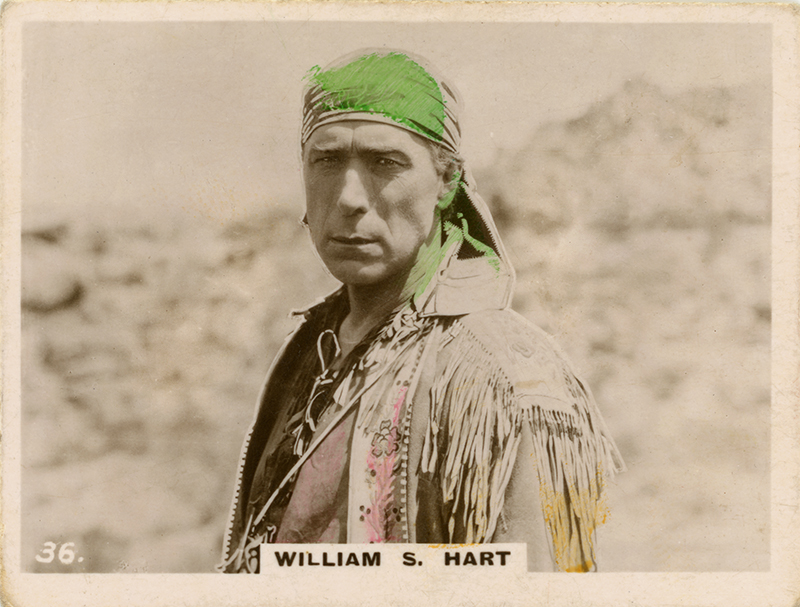|
|


Click image to enlarge
| Download archival scan
William S. Hart, tobacco card, colorized real photo, glossy print, 2½x1⅞ inches. Back is blank. Probably early 1920s, based on the colorizing technique and the fact that Hart is costumed for, and the scenery is consistent with, "Wagon Tracks" (Paramount-Artcraft 1919). Issuer unknown. Purchased in 2018 from a vendor in Australia; unknown if originally issued in Australia. ("Wagon Tracks" was distributed overseas in 1921.) Has certain similarities (colorizing technique, font style) with the "Cinema Stars" series issued in England in the 1920s by British American Tobacco (BAT). Tobacco cards were inserted into packs of cigarettes and collected just like later bubble-gum cards.
About 'Wagon Tracks.' From Koszarski (1980:114): Produced by William S. Hart Productions; advertised as "supervised by Thomas H. Ince"; distributed by Paramount-Artcraft; released July 29, 1919; ©July 21, 1919; five reels (5158 feet). Directed by Lambert Hillyer; story and screenplay by C. Gardner Sullivan; photographed by Joe August; art director, Thomas A. Brierley; art titles, Irwin J. Martin. CAST: William S. Hart (Buckskin Hamilton); Jane Novak (Jane Washburn); Robert McKim (Donald Washburn); Lloyd Bacon (Guy Merton); Leo Pierson (Billy Hamilton); Bertholde Sprotte (Brick Muldoon); Charles Arling (The Captain). SYNOPSIS: The wagon tracks leading to Westport Landing are those of emigrants westward bound during the days of the gold rush. Buckskin Hamilton, a desert guide, comes down to meet the steamer on which he expects his younger brother Billy. On going aboard he learns that he has been killed, the story being that he was shot by Jane Washburn in self-defense. He credits part of the story — it is inconceivable that she deliberately shot him, but he suspects that her gambling brother Donald, and his confederate Merton, had something to do with the killing. These people accompany a long wagon train in the charge of Buckskin. On the desert one of the wagons carrying water falls over a precipice and the entire train is put on short allowance. Buckskin shows so much tender consideration for the weak and helpless at this time that Jane is deeply moved and confesses that the man killed had not annoyed her. Buckskin is now certain she did not do the shooting. He captures Donald and Merton at night, binds them to a lariat and drives them out on the desert to walk until one or the other confesses. They become half-crazed by thirst and accuse each other, the guilt being finally fixed on Donald. A band of Indians nearby has demanded of the emigrants the murderer of one of their number, a man for a man. Buckskin gives Donald the alternative of going to the Indians or of shooting himself. Donald attempts to escape, but is captured by the Indians and taken to the torture. The wagon train goes on now unmolested. On reaching its destination, Jane, who has learned to love Buckskin, seeks to restrain him from going over the trail, but he decides to leave her. She fondly hopes he will come back some day. He regretfully says "mebbe" and returns to his duty. [Moving Picture World, August 23, 1919] REVIEWS: The director saw to it that things were kept within reasonable bounds, even when there were chances to lay things on a bit thick ... it treats of an always romantic phase of American history. Those days back in '49 and '50 have been written, and screened over and over again, but the romance of the Westward trend of Americans is always of interest to the present generation, especially if the story is well presented and has more meat to it than the usual dance-hall mellers. [Wid's, August 17, 1919] A fairly good Hart picture, well constructed by the talented author, Gardner Sullivan, logical and consistent throughout, but dark in mood, presenting Hart in a vindictive and revengeful character... . The motives of revenge, so well suited to Continental audiences, are not so much in use here, possibly because they have been overdone in cheap melodrama, somewhat looked down upon by manly Americans of today... . [Louis Reeves Harrison, Moving Picture World, August 23, 1919]
LW3465: 9600 dpi jpeg from original tobacco card purchased 2018 by Leon Worden.
|
WATCH FULL MOVIES
Biography
(Mitchell 1955)
Narrated Biopic 1960
Biography (Conlon/ McCallum 1960)
Biography (Child, NHMLA 1987)
Essay: The Good Bad Man (Griffith & Mayer 1957)
Film Bio, Russia 1926
The Disciple 1915/1923
The Captive God 1916 x2
The Aryan 1916 x2
The Primal Lure 1916
The Apostle of Vengeance (Mult.)
Return of Draw Egan 1916 x2
Truthful Tulliver 1917
The Gun Fighter 1917 (mult.)
Wolf Lowry 1917
The Narrow Trail 1917 (mult.)
Wolves of the Rail 1918
Riddle Gawne 1918 (mult.)
"A Bullet for Berlin" 1918 (4th Series)
The Border Wireless 1918 (Mult.)
Branding Broadway 1918 x2
Breed of Men 2-2-1919 Rivoli Premiere
The Poppy Girl's Husband 3-23-1919 Rivoli Premiere
The Money Corral 4-20-1919 Rialto Premiere
Square Deal Sanderson 1919
Wagon Tracks 1919 x3
Sand 1920 Lantern Slide Image
The Toll Gate 1920 (Mult.)
The Cradle of Courage 1920
The Testing Block 1920:
Slides, Lobby Cards, Photos (Mult.)
O'Malley/Mounted 1921 (Mult.)
The Whistle 1921 (Mult.)
White Oak 1921 (Mult.)
Travelin' On 1921/22 (Mult.)
Three Word Brand 1921
Wild Bill Hickok 1923 x2
Singer Jim McKee 1924 (Mult.)
"Tumbleweeds" 1925/1939
Hart Speaks: Fox Newsreel Outtakes 1930
|
The site owner makes no assertions as to ownership of any original copyrights to digitized images. However, these images are intended for Personal or Research use only. Any other kind of use, including but not limited to commercial or scholarly publication in any medium or format, public exhibition, or use online or in a web site, may be subject to additional restrictions including but not limited to the copyrights held by parties other than the site owner. USERS ARE SOLELY RESPONSIBLE for determining the existence of such rights and for obtaining any permissions and/or paying associated fees necessary for the proposed use.







































